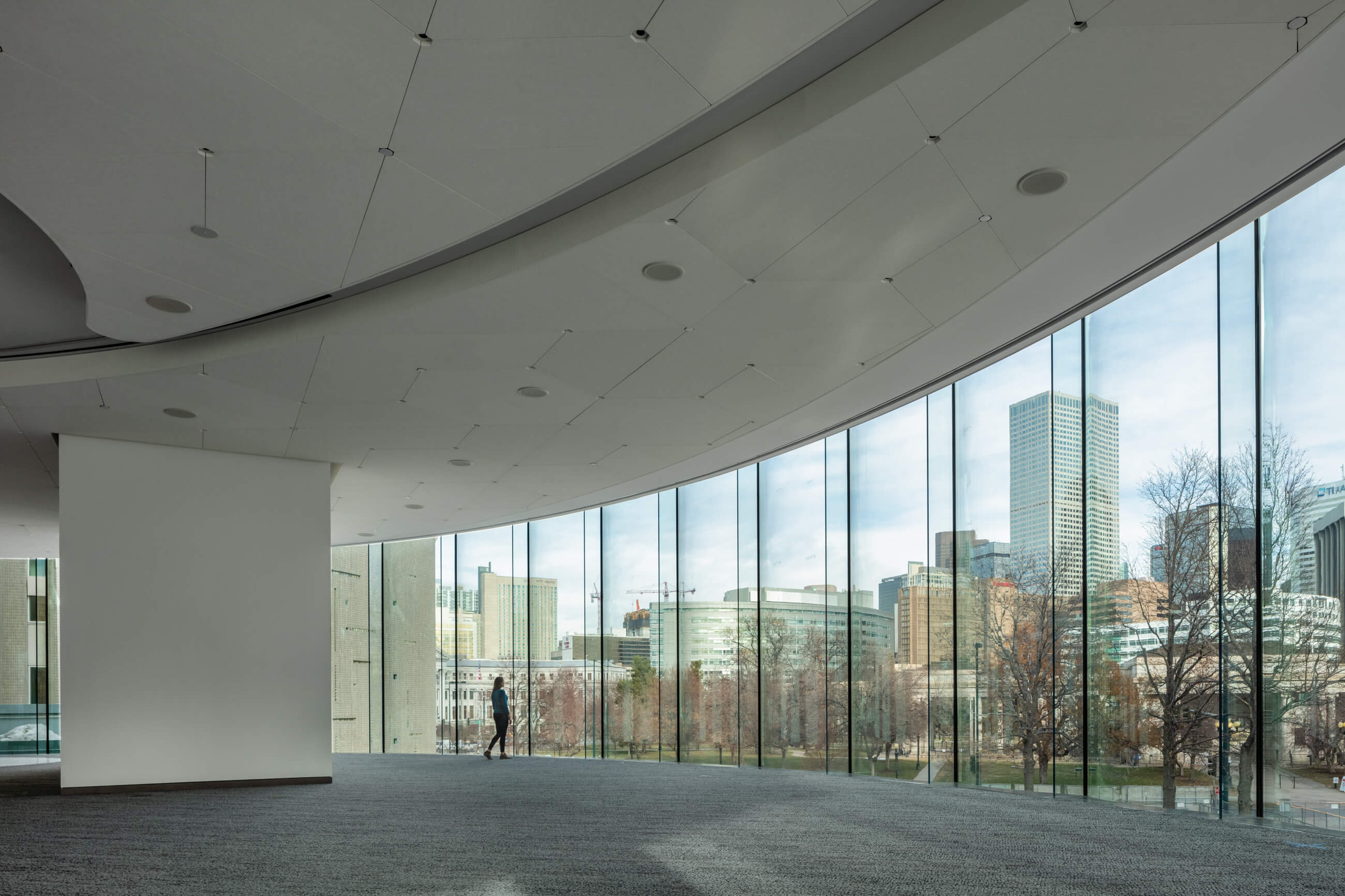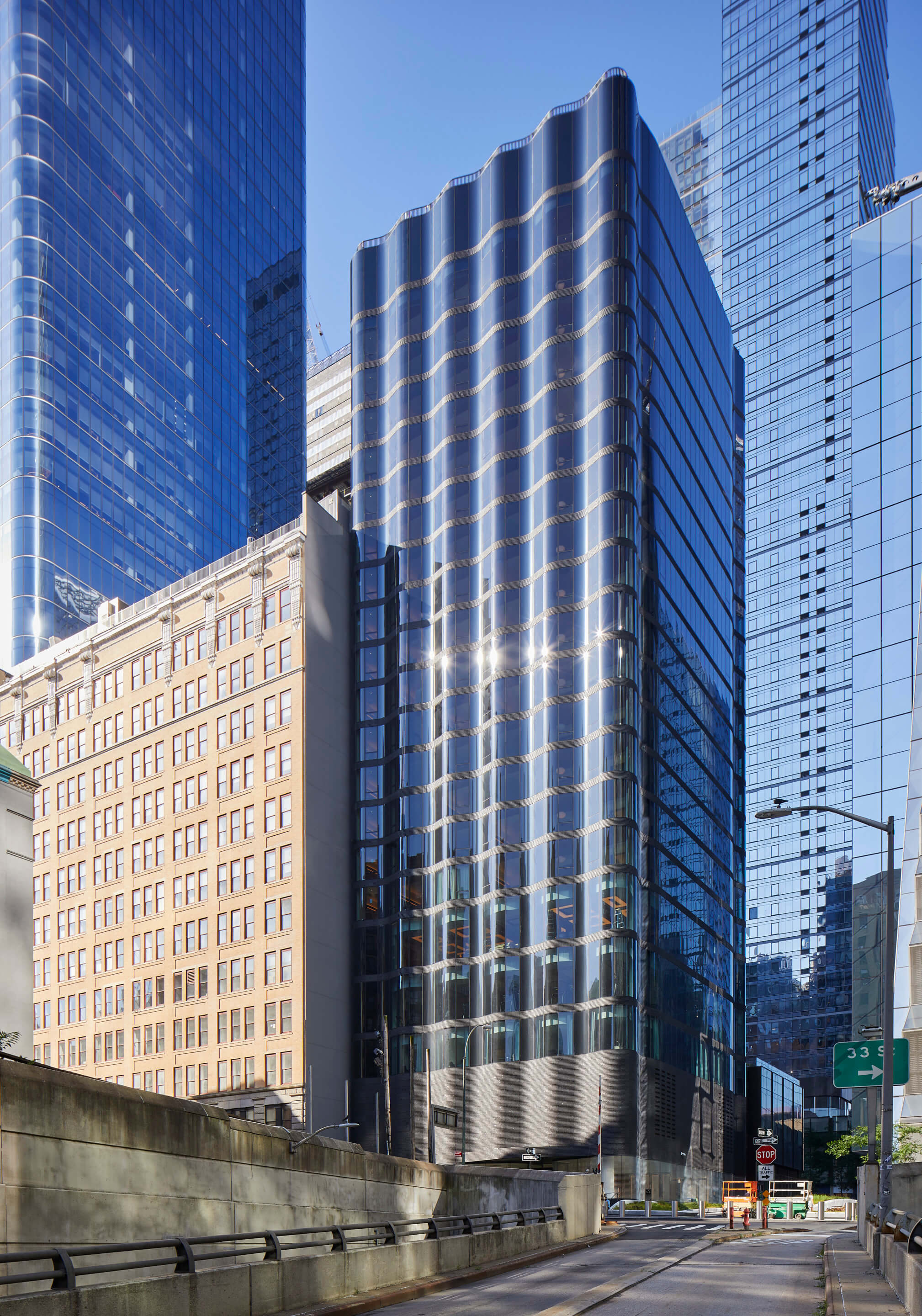
Up until the mid-20th century, the incorporation of glazing into any project was an exorbitantly expensive decision and potentially fraught with error due to the irregularity of manufacturing processes. The development of float glass through the Pilkington process, which can be roughly described as rolling molten glass over a tin bath, has enabled continually growing limits in glass sheet dimensions. Advances in the manufacturing process have occurred in conjunction with developments in treatments—such as annealing, lamination, fritting, and employing interlayers—that promise greater geometrical flexibility and aesthetic customization. The growth in capabilities of both manufacturing and treatment is now coming to fruition globally and across building scales in the form of ever more ambitious curved glass facades.
Tsai Center for Innovative Thinking at Yale, Weiss/Manfredi

Weiss/Manfredi’s Tsai Center for Innovative Thinking at Yale (Tsai CITY) is one such project currently pushing the boundaries of large-scale curved structural glass. The cross-disciplinary hub is located on a formerly forlorn concrete courtyard sandwiched between Marcel Breuer’s Brutalist Becton Engineering and Applied Science Center and the Neo-Tudor dean’s office. To magnify the context and conform to a narrow site, the architects opted for an elliptical plan enclosed with 72 convex-and-concave structural glass panels.
The geometry of the curved panels was developed in collaboration with facade consultant Front, which helped create a Grasshopper script capable of toggling radii of the panels at different positions along the ellipse, and Weiss/Manfredi further utilized the script to generate digital models for curvature analysis. “The elliptical geometry posed a challenge; a circular geometry is easy to divide into equal panels because the radius is consistent but the curvature of an ellipse changes continuously, so it needed to be simplified into a series of four different arcs,” said Weiss/Manfredi cofounders Marion Weiss and Michael Manfredi. “The four arcs allowed the ellipse to be divided into consistent panels that are approximately 5 feet wide, which minimized the variation in panel sizes.”
Each of the panels is also approximately 22 feet tall and has an 8-foot radius; those at the ends of the ellipse were adjusted by several feet to maintain a constant sinusoidal wave. Chinese manufacturer NorthGlass, which has developed global expertise in this area, produced the glass for the project, and Weiss/Manfredi and Front visited its Tianjin facility to verify tolerances and edge flatness, among other characteristics, prior to shipment to the United States. Connecticut-based facade contractor Fabbrica fabricated the facade system and produced 4-foot-tall mock-ups for review by the design team. Notably, the curvature of the individual panels provides sufficient lateral stability to avoid the use of mullions or girts. Each panel weighs several hundred pounds, and they were craned over the tops of surrounding buildings to be dead loaded onto curtain wall anchors and a curved metal channel; a similar channel ring is deployed at the roofline.
Denver Art Museum Welcome Center, Machado Silvetti and Fentress Architects

In 2016, Machado Silvetti and Fentress Architects were selected to lead the renovation of Gio Ponti’s iconic North Building at the Denver Art Museum, as well as the construction of an entirely new welcome center to the bridge museum’s campus (it also includes a Daniel Libeskind addition next door) and the surrounding Civic Center area. That brief informed the design concept for the welcome center: an elliptical pavilion enclosed with a scalloped structural glass curtain wall. Multiple rounds of conversation with fabricators and installers ultimately proved the feasibility of the design concept, and Sentech Architectural Systems along with Harmon were brought onto the project to put all the pieces together.
Prior to construction, Sentech Architectural Systems produced full-scale mock-ups of the panels to test the plan prior to installation. Additionally, the mock-ups were subjected to strenuous weather testing, as well as exposed to vertical and lateral structural loads. Both informed revisions of the finalized design.
The panels measure 8 feet wide and 25 feet tall and have a curve radius of 10 feet. Most of the panels weigh approximately 3,200 pounds, and they were craned into position by a custom-designed suction cup lifter and mounted on the facade system of stainless-steel angles. In lieu of view-hampering mullions, the curved panels are vertically supported by triple-laminated low-iron glass fins and are tied back to the primary steel through custom stainless-steel fittings. The bottom pins of the fins support the entire dead load of the glass, while the connection at the roof provides lateral support and permits the roof to deflect up to one and a half inches under snow loads and to drift from side to side by up to two inches to accommodate wind loads.
Pendry Manhattan West, SOM

In New York, a similar trend is underway, albeit jostling upwards to greater heights. SOM’s Pendry Manhattan West is one of the towers rising adjacent to the Hudson Yards megadevelopment in Brookfield’s Manhattan West, and in contrast to its surrounding rectilinear peers, it is clad with a unitized curtain wall system of curved glass framed by ribbons of black granite spandrels.
A principal goal of the project’s facade design was the elimination of unnecessary variables to establish both a streamlined design and a relatively straightforward installation process. In collaboration with Front, the design team opted for just three radius types around which the glass is bent. The tight radius for the curved glass, which is just under 5 feet, presented a challenge from a visual perspective due to distortion; highly transparent glass with shadow boxes at the spandrels, or a reflective glass coating, would have disrupted the intended uniformity of the facade. Ultimately, SOM selected a 5/16-inch tinted outer glass substrate that lessens the visual jump between concave and convex surfaces.
A greater performative challenge was found in the fabrication of the facade system’s aluminum extrusions, where minor tolerance issues could cause significant weatherproofing problems. “To avoid those issues, a specialized curving process was utilized,” explained SOM associate director Christoph Timm. “First, the straight aluminum extrusions were encapsulated in oversized aluminum sacrificial tubes, and the remaining voids were filled with a low-temperature-melting metal alloy. After the standard three-roller bending process, the assemblies were submerged in near-boiling water and the low-temperature infill metal was melted away. The outer sacrificial tubes were then discarded, and the curved aluminum extrusions were finally sanded down and coated.”
The black granite stone was quarried in Quebec by A. Lacroix Granit, and it was structurally tested to determine how thin each panel could be cut prior to being directly framed into each curtain wall unit.
La Samaritaine, Paris, SANAA

The use of curved glass is not particular to the United States; if anything, experimentation abroad plays a crucial role in the growing adoption of the material here. Over the past decade, Japanese firm SANAA has led the way in this regard with high-profile projects such as the Rolex Learning Centre, Louvre-Lens, and Grace Farms. More recently, the firm wrapped up a comprehensive overhaul of La Samaritaine department store in Paris for luxury goods company LVMH, and the project includes an entirely new structure enshrouded in a curtain of undulating and fritted glazing.
The project is located on Paris’s Rue de Rivoli, a storied commercial stretch largely composed of arcaded masonry buildings and symmetrical glazing bays. “The curves themselves were defined by analyzing the fenestration along the Rue de Rivoli: we assessed the patterns of neighboring fenestration and translated those rhythms into curves,” noted SANAA partner Lucy Styles. “We then developed 23 different curved panels along the length of the wave facade, and our intention was to create the impression of a continuous free-curve, all the while optimizing the number of variations in geometry.”
Spanish manufacturer Cricursa produced the undulating glass panels, which are of two sizes: approximately 11 feet or 14 feet tall, both nearly 8 feet wide. The curved panels form the outermost layer of the enclosure system, designed by German fabricator Frener & Reifer, and they are held at four points by stainless-steel brackets. Backing the curved glass is a secondary skin of flat glass heavily fritted with a white dot matrix screen print that can pivot to provide cleaning access. The innermost layer is composed of triple-glazed panels that bring the building up to the area’s stringent fire rating standards.
“The facade design was driven by a synthesis of various parameters: we addressed environmental demands through the layered use of serigraphy; visual demands by means of introducing a gradient to this serigraphy; fire regulations by separating the facade into a series of layers, the innermost layer being firebreak and alleviating the demands on the wave facade itself,” Styles said. “The greatest challenge was finding a balance between these many forces while maintaining the impression of an ethereal veil.”





